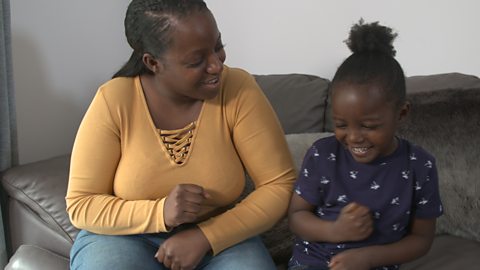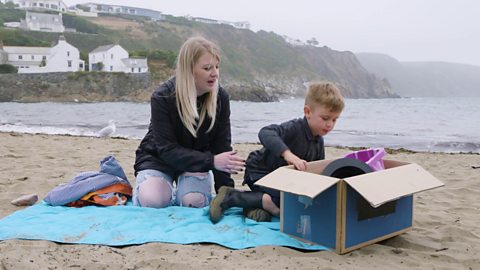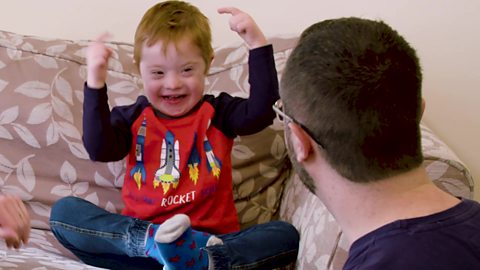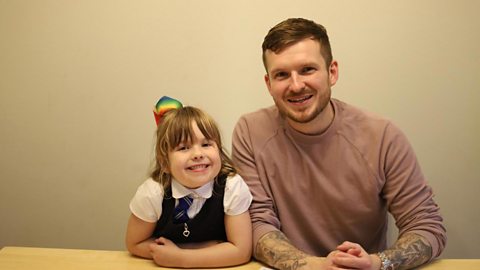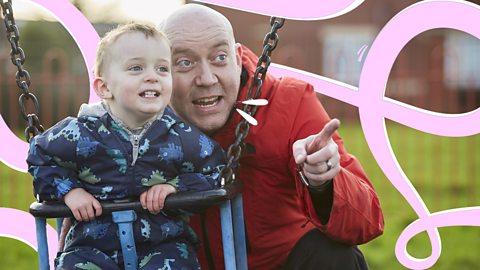Home > Activities > 4-5 years
Whether you're at the supermarket, the park or home, it is always a good time to practise rhyming words.
Recognising and producing rhymes is a key skill, which will help unlock important language and communication milestones when your child starts school.
Watch the video below to discover how to play this simple rhyming game with your child wherever you are.
What rhymes with swing?
Wing.
Wing.
When you do 'dadadadada'…What's that?
Sing!
You sing!
And what noise does a bell make?
RING RING RING RING
We're going to play a rhyming game.
Yeah. But first, let's get on our coats.
What rhymes with coat?
Boat! Boat. Good boy! What words can you think of that rhyme with the word cat?
Rat. Mat.
What do you put on your head?
Hat. Well done. What can you see?
Trees!
Can you see the trees?
Yeah!
What colour are the trees?
Green.
Wow… There's lots of them, isn't there?
Come and show us the trees. Where are they?
They're over there!
And what rhymes with tree? And goes [buzz]?
A bee! Bee, that's right.
What's next to the sand?
The sea.
The sea.
Let's make a sentence with all the words that rhyme with cat.
The cat sat on the mat.
Yeah, well done.
Because they all end with the sound 'at'. And that's why it's called cat. And that's why it's called a rhyme. I can see a house! Can you?
Yeah!
What rhymes with house? What about a little animal?
Mouse! Mouse!
That's right. Mouse does rhyme with house. You're getting the hang of these rhymes, aren't you!
What are the language benefits of rhyming with children?
- Talking about words that rhyme can help children recognise sounds in words.
- Spotting similar sounds in words helps expand vocabulary and teaches children how language works.
- Research has found that being familiar with nursery rhymes and the words within them can help children learn to read.
- Understanding the patterns of rhyming helps children understand that words that share common sounds often share common letters.
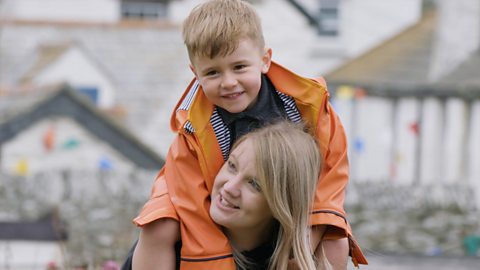
5 more rhyming activities for children
1. Build a sentence with rhyming words
How many rhyming words can your child fit into one sentence?
Help your child build a sentence with a set of rhyming words, such as "the cat sat on the mat". Try adding rhyming words to your sentence together for a fun challenge.
2. Sing nursery rhymes
Nursery rhymes are an excellent way to begin teaching your child this early phonological awareness skill.
Find some nursery rhyme inspiration for you and your child.
3. Changing nursery rhyme words
Changing the words to a favourite nursery rhyme is a fun way for your child to experiment with new rhyming words.
Find out more about this fun rhyming activity.
4. Rhyming I spy
Instead of looking for words beginning with a certain sound, ask your child to find something in the room that rhymes with another word.
This is a great way to practise recognising those important sounds in words.
5. Category rhyming words
Pick a topic with your child, such as holidays or nursery. Have fun together finding rhyming words for different words in that topic.
See it in action with Daddy Freckle and his daughter Flo.
More rhyming inspiration and information
- Early years practitioner Jamel Campbell explains what phonological awareness is and shares his top tips to support it.
- Discover why exploring word sounds is a key tool for language learning.
- See the influence of rhyming words on a child's brain in our speech lab.
- This BBC Bitesize learning guide on rhyming words explains what rhymes are very clearly for your child.


